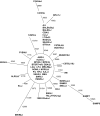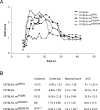Dissecting the effects of mtDNA variations on complex traits using mouse conplastic strains
- PMID: 19037013
- PMCID: PMC2612955
- DOI: 10.1101/gr.078865.108
Dissecting the effects of mtDNA variations on complex traits using mouse conplastic strains
Abstract
Previous reports have demonstrated that the mtDNA of mouse common inbred strains (CIS) originated from a single female ancestor and that mtDNA mutations occurred during CIS establishment. This situation provides a unique opportunity to investigate the impact of individual mtDNA variations on complex traits in mammals. In this study, we compiled the complete mtDNA sequences of 52 mouse CIS. Phylogenetic analysis demonstrated that 50 of the 52 CIS descended from a single female Mus musculus domesticus mouse, and mtDNA mutations have accumulated in 26 of the CIS. We then generated conplastic strains on the C57BL/6J background for 12 mtDNA variants with one to three functional mtDNA mutations. We also generated conplastic strains for mtDNA variants of the four M. musculus subspecies, each of which contains hundreds of mtDNA variations. In total, a panel of conplastic strains was generated for 16 mtDNA variants. Phenotypic analysis of the conplastic strains demonstrated that mtDNA variations affect susceptibility to experimental autoimmune encephalomyelitis and anxiety-related behavior, which confirms that mtDNA variations affect complex traits. Thus, we have developed a unique genetic resource that will facilitate exploration of the biochemical and physiological roles of mitochondria in complex traits.
Figures




Similar articles
-
Construction and characterization of a genomic BAC library for the Mus m. musculus mouse subspecies (PWD/Ph inbred strain).BMC Genomics. 2005 Nov 16;6:161. doi: 10.1186/1471-2164-6-161. BMC Genomics. 2005. PMID: 16288658 Free PMC article.
-
Mouse consomic strains: exploiting genetic divergence between Mus m. musculus and Mus m. domesticus subspecies.Genome Res. 2008 Mar;18(3):509-15. doi: 10.1101/gr.7160508. Epub 2008 Feb 6. Genome Res. 2008. PMID: 18256238 Free PMC article.
-
mtDNA polymorphism and metabolic inhibition affect sperm performance in conplastic mice.Reproduction. 2017 Oct;154(4):341-354. doi: 10.1530/REP-17-0206. Epub 2017 Jul 4. Reproduction. 2017. PMID: 28676531
-
Conplastic strains for identification of retrograde effects of mitochondrial dna variation on cardiometabolic traits in the spontaneously hypertensive rat.Physiol Res. 2021 Dec 30;70(Suppl4):S471-S484. doi: 10.33549/physiolres.934740. Physiol Res. 2021. PMID: 35199537 Free PMC article. Review.
-
Mitochondrial DNA evolution in mice.Genetics. 1983 Nov;105(3):681-721. doi: 10.1093/genetics/105.3.681. Genetics. 1983. PMID: 6315529 Free PMC article. Review.
Cited by
-
Nuclear response to divergent mitochondrial DNA genotypes modulates the interferon immune response.PLoS One. 2020 Oct 8;15(10):e0239804. doi: 10.1371/journal.pone.0239804. eCollection 2020. PLoS One. 2020. PMID: 33031404 Free PMC article.
-
Parent-of-origin effects on voluntary exercise levels and body composition in mice.Physiol Genomics. 2010 Jan 8;40(2):111-20. doi: 10.1152/physiolgenomics.00139.2009. Epub 2009 Nov 10. Physiol Genomics. 2010. PMID: 19903762 Free PMC article.
-
Mitochondrial DNA, nuclear context, and the risk for carcinogenesis.Environ Mol Mutagen. 2019 Jun;60(5):455-462. doi: 10.1002/em.22169. Epub 2018 Jan 14. Environ Mol Mutagen. 2019. PMID: 29332303 Free PMC article. Review.
-
The mtDNA nt7778 G/T polymorphism augments formation of lymphocytic foci but does not aggravate cerulein-induced acute pancreatitis in mice.PLoS One. 2014 Jul 10;9(7):e102266. doi: 10.1371/journal.pone.0102266. eCollection 2014. PLoS One. 2014. PMID: 25010670 Free PMC article.
-
Mitochondrial haplotype and mito-nuclear matching drive somatic mutation and selection throughout ageing.Nat Ecol Evol. 2024 May;8(5):1021-1034. doi: 10.1038/s41559-024-02338-3. Epub 2024 Feb 15. Nat Ecol Evol. 2024. PMID: 38361161 Free PMC article.
References
-
- Anderson S., Bankier A.T., Barrell B.G., de Bruijn M.H., Coulson A.R., Drouin J., Eperon I.C., Nierlich D.P., Roe B.A., Sanger F., et al. Sequence and organization of the human mitochondrial genome. Nature. 1981;290:457–465. - PubMed
-
- Canter J.A., Kallianpur A.R., Parl F.F., Millikan R.C. Mitochondrial DNA G10398A polymorphism and invasive breast cancer in African-American women. Cancer Res. 2005;65:8028–8033. - PubMed
-
- Capri M., Salvioli S., Sevini F., Valensin S., Celani L., Monti D., Pawelec G., De Benedictis G., Gonos E.S., Franceschi C. The genetics of human longevity. Ann. N. Y. Acad. Sci. 2006;1067:252–263. - PubMed
-
- De Benedictis G., Rose G., Carrieri G., De Luca M., Falcone E., Passarino G., Bonafe M., Monti D., Baggio G., Bertolini S., et al. Mitochondrial DNA inherited variants are associated with successful aging and longevity in humans. FASEB J. 1999;13:1532–1536. - PubMed
Publication types
MeSH terms
Substances
LinkOut - more resources
Full Text Sources
Molecular Biology Databases
